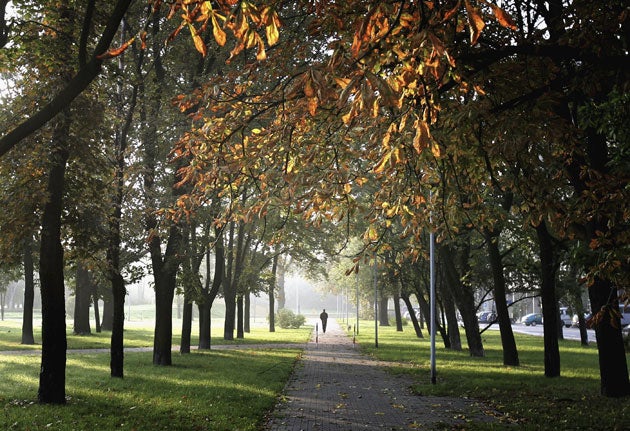Night-time light pollution is bringing spring forward by a week
Trees start to produce leaves up to 7.5 days early if bathed in light from street lamps and the knock-on effects mean less food for birds

Street lights are causing spring to arrive as much as a week earlier than normal in the UK – as far as trees are concerned.
Biologists from Exeter University found that the buds of trees such as the oak, sycamore, ash and beech were bursting up to 7.5 days earlier in the year in areas with a lot of artificial light.
The effect causes problems for insects such as the winter moth, which lays its eggs so the caterpillars will hatch at the same time as the trees produce their first tender young leaves.
Hatching a week too late means the caterpillars have to eat tough leaves packed with tannin – a natural defence against pests – that are less nutritious. And that means there are fewer caterpillars for songbirds to eat.
Professor Richard Ffrench-Constant, the lead author of a paper in the Proceedings of the Royal Society B journal, told The Independent: “Animals are clearly affected by day length and are correspondingly affected by artificial light. But I think the effects on plants have been overlooked.
“I think it’s very striking that we’re looking at the difference of a full week – consistently seeing a seven-day advance over a 13-year period. That’s a significant difference.”
This might not actually be a problem for the trees apart from a few “colder nights” and could even be beneficial because fewer of their leaves would be eaten, he said.
But it does pose a life-threatening problem for moth caterpillars.
“If the oak tree buds earlier, they’ll be feeding on leaves full of tannins and they won’t grow correspondingly,” Professor Ffrench-Constant said.
“If the caterpillars don’t respond to the same stimuli [the light], they are going to miss their window of feeding opportunity.”
This would be a “big deal” for the caterpillars “because you’re then confronted with an oak leaf full of tannins and you’re going to grow less quickly and might not make it”.
“And there will be less food for the songbirds,” Professor Ffrench-Constant said.
The trees are tricked into thinking the days are getting long enough to produce leaves by the red part of the spectrum.
And Professor Ffrench-Constant said it should be possible to make a street light that did not have this effect and also did not attract moths away from their normal role as important night-time pollinators.
“We can restore the balance of nature if we can use LED lights that remove the harmful wavelengths,” he said.
The study was carried out using information collected by ‘citizen scientists’ from across the UK, after the Woodland Trust asked them to note down when they first saw sycamore, oak, ash and beech trees in leaf as part of the charity’s Nature’s Calendar initiative. The researchers then compared this with satellite images of artificial lighting.
Dr Kate Lewthwaite, a citizen science manager at the Woodland Trust, said: “Analysis of Nature's Calendar data suggests that increased urbanisation is continuing to put pressure on the natural world, in ways that we could not have foreseen.
“As the seasons become less and less predictable, our native wildlife may struggle to keep up with fluctuations that affect habitats and food sources.
“Hopefully this research will lead to new thinking on how to tackle such issues, and will help influence future development decisions.”
Join our commenting forum
Join thought-provoking conversations, follow other Independent readers and see their replies
Comments